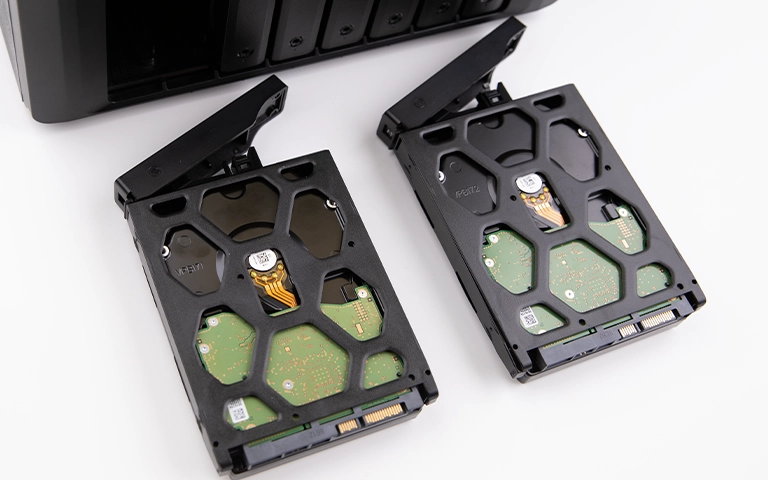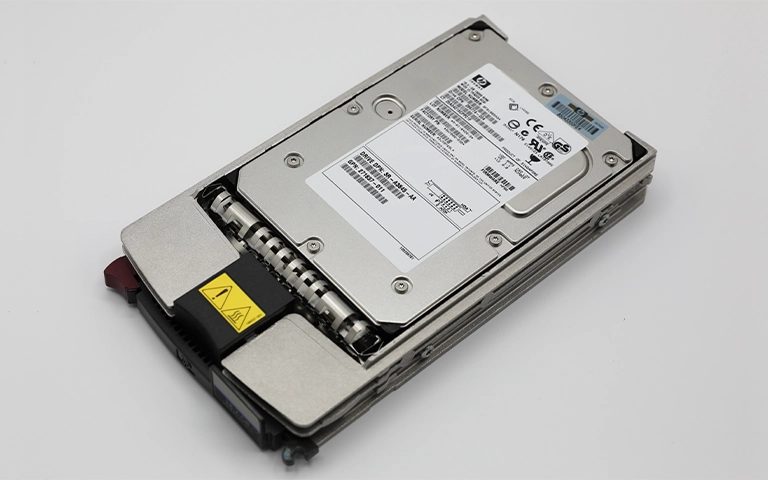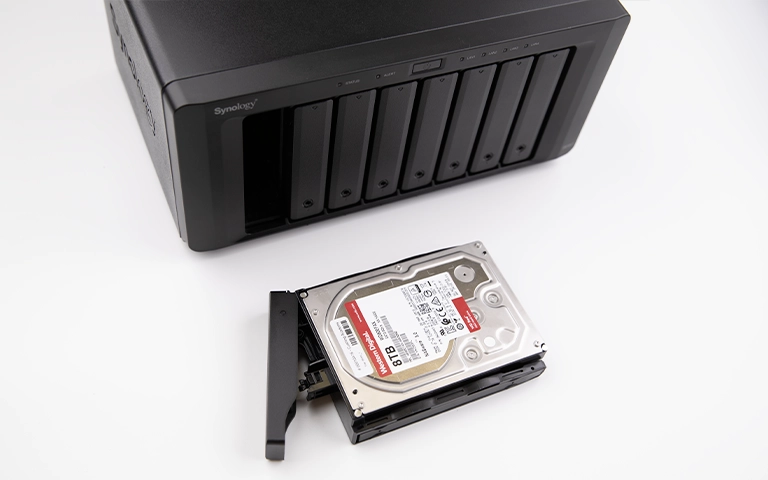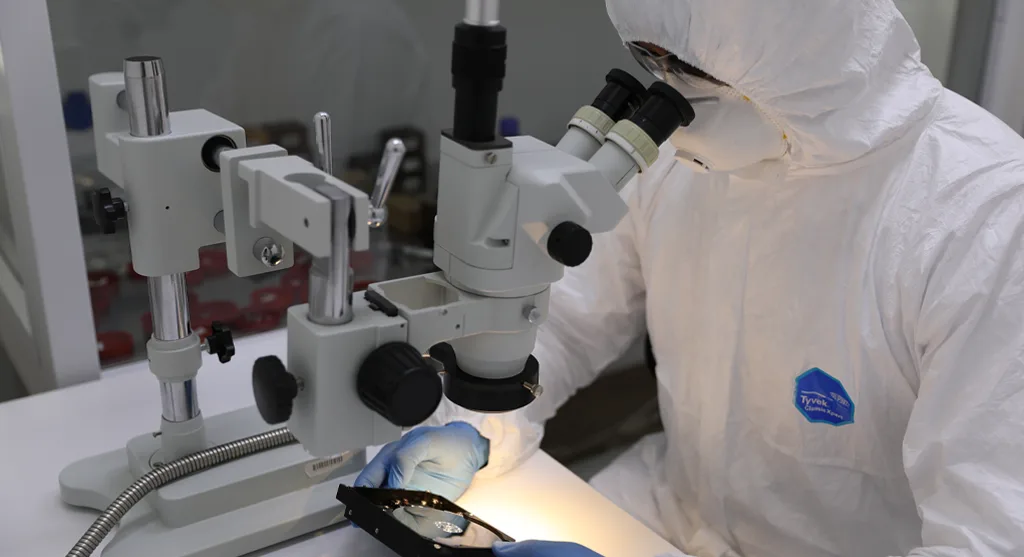When a RAID array fails, every decision matters. This step-by-step guide will help you troubleshoot RAID failures safely, giving you a clear understanding of the issue without putting your data at further risk.
Whether you’re facing a degraded RAID 5, a NAS system that won’t boot, or multiple failed drives, this guide can help you assess the situation before taking action.

Common RAID Failure Symptoms
RAID volume not detected or failing to mount
System fails to boot or displays “No boot device found”
Drives flagged as “degraded” or “offline”
RAID management utility reporting “Array Failed”
Unusual drive noises such as clicking, buzzing, or silence (no spin)
Files missing, corrupted, or inaccessible
For a more detailed look at the causes of RAID degradation and safe response strategies, see our Degraded RAID Recovery Guide.
Step-by-Step RAID Troubleshooting Guide
The following steps are designed for observation and safe diagnosis. Do not attempt changes unless you are certain of their consequences.
Step 1: Identify Your RAID Level
Different RAID levels respond to failure in different ways:
RAID 1 – can tolerate the loss of one drive
RAID 5 – can sustain one drive failure, a second is critical
RAID 0 – cannot withstand any drive failure
You can confirm your RAID level in the system utility, controller logs, or original configuration documentation.

Step 2: Power Down and Check Connections
Shut down the system safely
Unplug and re-seat SATA or SAS cables
Confirm all drive and power connections are secure
In some cases, what appears to be a RAID failure is simply the result of a loose cable.
Step 3: Listen to the Drives (HDD Systems)
If your RAID uses traditional hard disk drives (HDDs), pay attention to the sounds when powering on:
Normal sounds: brief spin-up followed by a steady, low hum
Abnormal sounds: repeated clicking, ticking, buzzing, grinding, or complete silence
If abnormal noises are detected, power down immediately. These may indicate mechanical issues such as a head crash or spindle seizure. Continuing to run the system can cause further damage and complicate recovery.
For a detailed explanation of clicking and other abnormal drive noises, see our Clicking Hard Drive Guide.
Step 4: Access the RAID Controller Utility
Enter your RAID controller BIOS (such as LSI, Dell PERC, or Intel RST) by pressing the relevant hotkey during startup (commonly Ctrl+R, Ctrl+I, or similar).
At this stage, only observe and record the status:
Are all drives being detected?
Which drive(s) are flagged as “Failed” or “Missing”?
Is the array marked as “Degraded,” “Failed,” or “Ready”?
Do not attempt a rebuild or initialisation at this point. Instead, document the findings carefully for further analysis or professional review.
Step 5: Stop if You See These Red Flags
Certain signs suggest that proceeding further could cause permanent data loss. Stop immediately if you encounter:
Multiple drives reported as failed
A drive flagged with “foreign configuration”
Uncertainty over the correct disk order
Clicking, grinding, or other abnormal drive noises
These indicators mean the array is at high risk. Taking the wrong action at this stage can make recovery far more difficult or impossible without specialist intervention.

Step 6: Back Up Data (If Accessible)
If the system is still able to boot and the RAID volume remains accessible:
Copy all critical data immediately
Avoid running defragmentation or disk repair utilities
Do not restart the system unless absolutely necessary
Trust the experts with proven results
What NOT to Do
Avoid these critical mistakes when dealing with a RAID failure:
Do not attempt a rebuild if you are uncertain about drive order or RAID configuration
Do not initialise or format any part of the array
Do not run third-party recovery software on a failing RAID
Do not use tools such as CHKDSK or fsck on degraded arrays
Do not clone drives without specialist, hardware-based imaging equipment
Any of these actions could worsen the damage and make professional recovery impossible.
When to Call a Professional
Stop troubleshooting and contact a RAID recovery specialist immediately if:
More than one drive is degraded or failed
A rebuild has already been attempted without success
The data is business-critical or irreplaceable
The drives emit unusual noises such as clicking or grinding
Errors occur after a virtualisation failure or firmware bug
Fast turnaround times for business-critical data

Why Choose RAID Recovery Services
We specialise in handling complex RAID recovery cases every day, including:
RAID 0, 1, 5, 6, 10, 50, 60, and nested configurations
Failures caused by physical damage, incomplete rebuilds, or lost metadata
Server, NAS, and SAN failures across QNAP, Synology, Dell, HP, and other platforms
Virtualised RAID environments such as VMware and Hyper-V
Our engineers work in ISO-certified cleanrooms and use bespoke imaging and reconstruction tools, capabilities far beyond what generic data recovery software can provide.
Frequently Asked Questions
Can I rebuild my RAID if only one drive has failed?
Only if you are completely certain about the correct drive and RAID configuration. Even a small mistake in drive order can destroy the entire array.
Can I use recovery software on my RAID?
No, not unless the array has first been fully imaged, cloned, and rebuilt in a virtual environment. Any software that writes directly to the array can compromise data integrity.
Is it possible to recover a RAID after a failed rebuild?
Yes. We specialise in post-rebuild recovery. The sooner you stop further attempts, the higher the chance of a successful outcome.
Do you recover RAID from NAS and virtual servers?
Absolutely. We handle recovery from QNAP, Synology, and TrueNAS systems, as well as virtual environments such as VMware ESXi and Hyper-V.